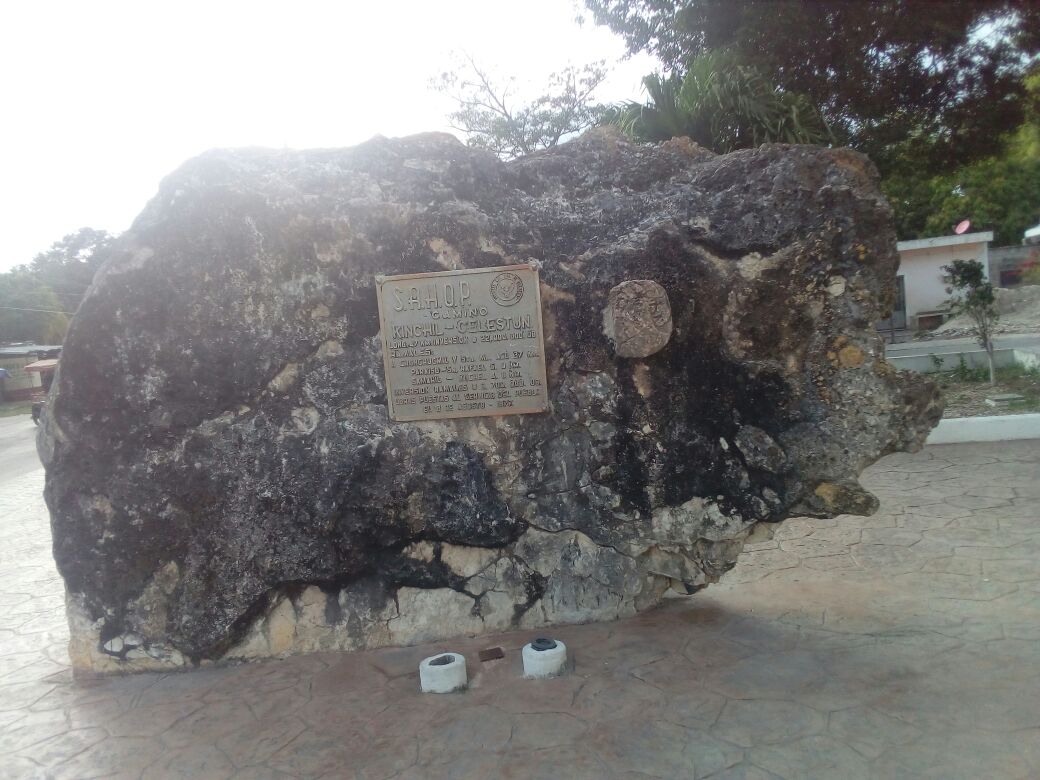the stone pig/el cochino de piedra
hola amigos de steemit , hoy les quiero compartir un poco de historia de un pueblo llamado kinchil perteneciente al Estado de Yucatán ,México.
hello friends of steemit, today I want to share a little history of a town called kinchil belonging to the State of Yucatan, Mexico.
antes de que nada quiero decirle que kinchil en la lengua maya significa "lugar donde se oculta el sol".
before anything I want to tell you that kinchil in the Mayan language means "place where the sun is hidden".
Este post se lo dedico al cochino de piedra que se encuentra en el parque la colonia conocida como la glorieta de ese poblado ,les contare todo lo que logre investigar.
This post is dedicated to the stone pig that is in the park the colony known as the gazebo of that town, I will tell you everything I can find out.


¿Donde se encontró?
Esta peculiar piedra se encontró en el kilométros 7 aproximadamente de la carretera Kinchil-celestún , lo encontrar en ese entonces por una empresa que se encontraba sacando piedras para verderlas , debo mencionar que Yucatán,México es caracterizado porque es una estado que su piso es muy lajoso en otras palabras hay más piedras que tierra ,es por eso que los mayas lograron hacer cosas asombrosas con ellas un ejemplo es la pirámide de Chichen itzá.
Where was it found?
This peculiar stone was found in kilometer 7 of the Kinchil-Celestun road, it was found at that time by a company that was taking stones to see them, I must mention that Yucatan, Mexico is characterized because it is a state that its floor is very lajoso in other words there are more stones than earth, that is why the Mayans managed to do amazing things with them. An example is the Chichen itza pyramid.


¿como llego al parque ?
cuando lo encontraron ,varios señores que trabajan en ese lugar donde sacaban piedras dijieron que se parecía un cochino y lograron quedarse con ello y logrando traerlo en una máquina en la entrada del municipio ,pero tiempo después lo trasladaron al parque de la glorieta en el que se encuentra por 30 años esa piedra logro ser un atractivo turístico para todas las personas que iban camino a la ria de celestún, yucatán.
How do I get to the park?
When they found him, several gentlemen who work in that place where they took out stones said that it looked like a pig and managed to keep it and managed to bring it in a machine at the entrance of the municipality, but later they moved it to the park in the roundabout. For 30 years this stone has been a tourist attraction for all the people who were on their way to the ria de Celestún, Yucatan.

¿cuantos años tiene en el parque?
esta piedra lleva aproximamente más de 30 años en el parque de la glorieta.
How old are you in the park?
this stone takes approximately more than 30 years in the park of the gazebo.
¿ mitos y rumoes sobre ese piedra?
Lo que hizo más famoso es que los habitantes dicen que esa piedra se mueve una vez al año y como lo encontraron el monte tiene que volver al monte , otras personas dicen que es era juguete de los aluxes
Myths and rumouses on that stone?
What made it more famous is that the inhabitants say that this stone moves once a year and as they found it the mountain has to go back to the mountain, other people say that it was a toy of the aluxes


¿Aluxes ?
Estos son parte esencial del imaginario maya, sobre todo en la Península de Yucatán, Guatemala y Belice. De hecho, es tan fuerte esta tradición mitológica en la zona, que aún hoy se realizan ofrendas a los duendes para que protejan los hogares o provean de provechosas cosechas.
Se cree que los aluxo’ob o aluxes son seres pequeños, cuya estatura sólo se acerca a la altura de las rodillas de una persona adulta. La creencia apunta que estos seres son generalmente invisibles (como en la nórdica o la bretona, curiosamente); estos adquieren forma humana para espantar a los humanos o hacer fechorías, sobre todo cuando hay una amenaza al bosque. Sin embargo, en realidad son seres protectores, simpáticos y solidarios. Ellos, con las demás criaturas del bosque, son la manifestación de las fuerzas de la naturaleza y de los 4 elementos. En el México maya viven también en las grutas y cenotes.
English
Aluxes?
These are an essential part of the Mayan imaginary, especially in the Yucatan Peninsula, Guatemala and Belize. In fact, this mythological tradition is so strong in the area, that still offerings are made to the elves to protect homes or provide profitable crops.
It is believed that the aluxo'ob or aluxes are small beings, whose stature only approaches the height of the knees of an adult person. The belief suggests that these beings are generally invisible (as in the Nordic or the Breton, curiously); they acquire a human form to frighten humans or do mischief, especially when there is a threat to the forest. However, in reality they are protective, sympathetic and supportive beings. They, with the other creatures of the forest, are the manifestation of the forces of nature and the 4 elements. In Mayan Mexico they also live in caves and cenotes.
fuente
BLADE V6 PLUS
Espero les haya gustado mi post amigos ,solo les queria compartir un poco de mi Yucatán,México.